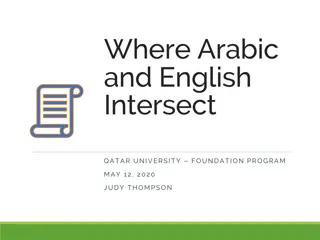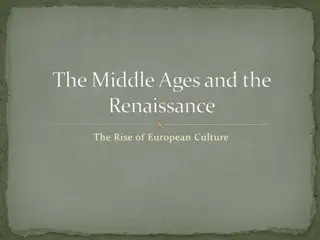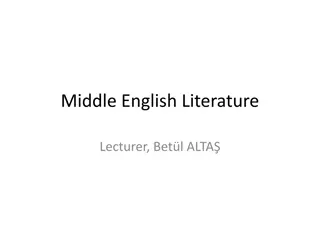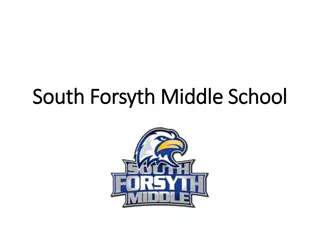Understanding Middle English Evolution
The Middle English period began after the Norman invasion of 1066 and extended to the mid-15th century, witnessing significant linguistic changes influenced by Scandinavian and Norman French languages. This era saw alterations in phonology, morphology, syntax, and vocabulary, reflecting the impacts of foreign invasions on English grammar and word order. The emergence of Norman French as a dominant language among rulers and the aristocracy, alongside the subsequent resurgence of English in the written form, played pivotal roles in shaping the evolution of the English language during this transformative period.
Download Presentation

Please find below an Image/Link to download the presentation.
The content on the website is provided AS IS for your information and personal use only. It may not be sold, licensed, or shared on other websites without obtaining consent from the author. Download presentation by click this link. If you encounter any issues during the download, it is possible that the publisher has removed the file from their server.
E N D
Presentation Transcript
MIDDLE ENGLISH Lecture 3
Lecture 3: Middle English 3.1. General Background 3.2. Changes in Spelling 3.3. The Middle English Phonetic System 3.4. The Middle English Grammar 3.5. The Middle English Vocabulary 3.6. The Middle English Literature
General Background The Middle English period started after the Norman invasion of 1066 and lasted to the middle of the 15th century. It is marked by changes in phonology, morphology, syntax and vocabulary which occurred 1) under the influence of the Scandinavian languages during the Scandinavian invasion (8th century 11thcentury), 2) mainly, under the influence of Norman French (and Latin) during the Norman Conquest of Britain.
General Background Scandinavian influenced mostly English grammar which resulted in a loss of word endings, and a greater reliance on word order, though the sphere of vocabulary was also affected. Norman French (introduced by Norman invaders) became the language of the rulers, the church, the government, the military, and the aristocracy. The English learnt French to gain advantages from the aristocracy; while the aristocracy learnt English to make contacts with the local English people.
General Background English was replaced in official documents and other records by Latin and reappeared in the written form only in the 13thc. West Saxon lost its supremacy, became diminished in area and was named the South Western. The Northumbrian dialect was divided into Scottish and Northern. The Mercian dialect was split into East and West Midland. The Kentish dialect was extended and called South Eastern. By the end of the 14thc., the status of French diminished due to growing English nationalism and the London dialect (Anglian in character) became influential in different parts of the country and eventually became the base of the national English language.
Changes in Spelling Considerable changes in the spelling reflected Norman spelling traditions brought to Britain by French scribes. Features: the runic letters , , , disappeared. New letters g, j, k, q, v, and letter combinations th, sh, ch, gh, ph, qu, ou, ow appeared. and th: e.g. OE wi > ME with; OE t > ME that The length of vowels was often shown by double letters: OE b k > ME book. The letters u and v were often used interchangeably: but or bvt.
Changes in Spelling The combination ou [u:] e.g. round [ru:nd], house [hu:s]. The letter c [k] only before back vowels; before front vowels c [s]. In some words c was replaced by k, e.g. OE cind > ME kind. The sound [k] ck, e.g. OE b k > ME back. The combination gh [h], e.g. OE niht > ME night. The sound [j] was denoted by y. The combination ie [e:]: OE chef > ME chief [t e:f]. The letter o [u], e.g. OE cumin > ME comen (to come)
The ME Phonetic System Most unstressed vowels were reduced to the letter e [ ]: e.g. OE talu > ME tale; The unstressed OE [i] often remained unchanged in ME: e.g. OE englisc > ME english; OE [e] in unaccented prefixes often became [i]: e.g. OE beforan > ME bifore; Unstressed long vowels were shortened in ME: e.g. OE d m (w sd m) > ME dom (wisdom).
The ME Phonetic System Vowels in the stressed position: OE [ ] > ME [ ] (OE r d > ME r d) (road) OE [ ] > ME [ ] (OE s > ME s ) (sea) OE y, [ ] > ME [i], [ ] (OE hyll > ME hill) A long vowel was often shortened before two consonants, OE c pte > ME kept Short vowels a, e, o were pronounced longer in open syllables: e.g. OE macian > ME m ken (to make) All OE diphthongs were monophthongized in the 11th century, having lost their 2ndelement: e.g. OE > ME (d p > d p=deep).
The ME Phonetic System Changes in the consonant system were not numerous. Some new consonants were developed due to the process of palatalisation: e.g. OE [sk ] > ME [ ] (OE scip > ME ship) e.g. OE [k ] > ME [ ] (OE c ld > ME child) e.g. OE [gg ] > ME [ ] (OE brycg > ME bridge) Some sonorants became vowels and new diphthongs appeared. OE [ ] (the letter g) turned into ME u, w [u, w]: e.g. OE dragan > ME drawen=drauen. So, new letters and diagraphs appeared to indicate new consonant sounds. Some letters and diagraphs were introduced by French scribes to indicate the existing sounds.
The Middle English Grammar The grammatical system of the English language underwent considerable changes. Many of the grammatical endings were dropped and the case-ending system was simplified (the phonetic tendency to reduce an unstressed vowel). English was transformed into an analytic language, with analytic forms prevailing over syntactic ones. There appeared a new part of speech the article, which developed from the demonstrative pronouns.
The Middle English Grammar The noun declension underwent changes: it became simpler. The grammatical category of case was reduced from 4 cases in OE to 3 cases in Early ME and, finally, 2 cases in Late ME. Thus, the case system comprised 2 cases: Common case a result of fusion of the Nominative, the Dative, and the Accusative. It had a very general meaning and indicated the subject or the object. Genitive remained and indicated possession. An alternative to Genitive of-phrase : the Genitive case was used for living beings and of-phrase for inanimate objects.
The Middle English Grammar The category of number preserved the formal distinction of two numbers: Singular and Plural. In Late ME the ending -es was the common marker of the nouns in the plural. The ME ending -en was a plural marker with some nouns but it was not as productive as -es (oxen, eyen, eiren). A small group of ME nouns had similar forms of the singular and the plural (deer, hors, thing etc.). Former root-stems were treated as exceptions as they demonstrated different vowels in the singular and the plural: man men, foot feet, mous mis.
The Middle English Grammar The adjective underwent considerable simplifying, it lost all the grammatical categories except for the degrees of comparison. They were formed with the help of suffixes -er and -est. The interchange of the root-vowel was less common than before. A new tendency typical of the ME adjective system was the development of analytic forms of the degrees of comparison more and most(e), which were used with all kinds of adjective e.g., more swete, more hard, moste clennest
The Middle English Grammar The pronouns were also subjected to extensive grammatical changes. Personal pronouns lost dual number. The Accusative and the Dative fused into one form called the Objective case; The Genitive case transformed into a separate group named possessive pronouns . Thus, the ME personal pronouns had only two cases: the Nominative and the Objective.
The Middle English Grammar In Early ME the OE demonstrative pronouns lost their categories of case and gender but preserved the category of number. There appeared two types of demonstrative pronouns: this (OE is) thise, thes(e) and that (OE t) tho, thos(e). The ME period is marked by the appearance of the definite article. People started using the demonstrative pronoun s as an article in Late OE and in Middle English it acquired the form of the definite article the.
The Middle English Grammar The verb retained the categories of tense, mood, number, person, strong, weak and other verbs. Strong verbs were represented by 67 verbs; all the other strong verbs acquired weak forms. Weak verbs also witnessed many losses but also get many borrowings from Norman French (e.g. cover, join, move, notice, plead, please, save, spend, store, waste) and Scandinavian (cast, crawl, glitter, lift, raise, want, etc.).
The Middle English Grammar There developed more verbal categories: the category of voice, the category of aspect, and the future tense. The Future modal verbs shall and will lost their lexical meaning and started to express the future meaning: e.g. Me thinketh that I shal reherce it heere (I think I ll retell it). Analytic forms of the Subjunctive Mood appeared formed by means of should / might + an infinitive, e.g. This Arcite and this Palamoun myghte han lyved in Thebes royally (Lo, here, Arcita and this Palamon might have lived in Thebes right royally).
The Middle English Grammar The Passive Voice appeared in ME having developed from the OE verb phrase: OE beon / weor an + Participle II of transitive verbs. It expressed not only states, but also actions, e.g. And that was sayd in forme and reverence (It was said politely and respectfully). Perfect forms developed from the OE possessive construction: habban + a direct object + Participle II of a transitive verb. e.g. < >That hem hath holpen (< > who has helped them).
The Middle English Vocabulary The principal means of enriching vocabulary in ME was external. As a result, the vocabulary shows many borrowings from Scandinavian, French and Latin. About 10,000 French words (administrative, social, military, law terms; religious words, literary terms, words describing clothing and food etc.) came into the English language during the Middle English period.
The Middle English Vocabulary 1) in some of the cases native words were replaced by French synonyms: e.g. OE leod > ME people e.g. OE here > ME army 2) English and French words were often preserved but with a difference in meaning and specific stylistic colouring, as French borrowings were often found on higher stylistic levels in English. Native word vs more formal Roman word: ox beef; sheep mutton; swine pork, begin commence, help aid; hide conceal
The Middle English Vocabulary Borrowings from Latin were not numerous, though more learned in character: frustrate, genius, incredible, index, solitary, suppress, testimony. As a result of Middle English borrowing from French and Latin, Modern English has sometimes synonyms on three levels: popular (English), literary (French), and learned (Latin): rise mount ascend; ask question interrogate; fire flame conflagration.
The Middle English Vocabulary About 650 Scandinavian (Sc) borrowings came into English. A new word was added to the vocabulary as there was no synonym in English or the English synonym was replaced by the Scandinavian borrowing: e.g., NE clypian was replaced by callen, e.g., NE niman was replaced by taken. In some cases both English and the corresponding Sc words were preserved but they became different in meaning: OE steorfan (to die) > ME sterven > NE starve (to die from hanger) versus Sc deyia (to die). Some of the OE words were preserved but changed their meaning in Middle English, e.g. OE clerec (clergyman) acquired a new meaning in ME student , scholar etc.
The Middle English Vocabulary In Middle English the Old English word-forming powers were reduced, Still, the two main internal means of developing the vocabulary were affixation and composition. Many of the OE prefixes lost their ability to enter into new combinations. For example, the OE prefix for- was only occasionally used in ME, e.g. forcleave (to cut to pieces). The OE prefix with- gave only a few new words in ME. There existed several productive word-building prefixes, for example, a number of ME verbs were formed with the help of prefixes, such as mis-, un-, be-.
The Middle English Vocabulary Some of the suffixes remained productive: - the noun-suffixes -ness, -ung (ing), -end, -el, -ling, -hede, - the adjective-suffixes -som, -ish, -ful, -less, -ed, -en, -ig (- y), -ly (-lich), -wise. Some suffixes mostly lost their importance in ME -dom, -hood, - ship etc. The suffix -er(e) was productive to form nouns both from OE words and borrowings. The suffix -en was productive to form verbs -en: loosen, blacken. A number of Romance suffixes were introduced in the ME period, such as -acy, -age, -al, -aunce, -ite, -ment, -ant, -ard, -esse, -ist, -our, -able, -al, -ive, -ous as in servant, minister, conquerour, moral etc.
The Middle English Vocabulary Besides, a new way of word-formation based on homonymous forms of nouns and verbs resulting from the reduction of unstressed vowels (conversion) appeared in Middle English as in chance, call, smile. Finally, compounds remained frequent in Middle English. Many OE compounds had disappeared and many new compound words had been created, e.g., barehead, love-drink, shoulder-bone.
The Middle English Literature There had been two written languages in Britain: Latin and French, while English was a language of everyday communication and was considered to be unfit for writing. The earliest works in ME were mostly religious texts Another kind of literature which gained popularity in ME is works describing the life and adventures of knights (King Arthur and the Knights of the Round Table written in a West Midland dialect). Many of the ME literary works were anonymous: The Owl and the Nightingale, The Fox and the Wolf (late 12thc. and early 13thc. respectively), King Horn (mid 13thc.) and The Lay of Havelock the Dane (late 13thc.).
The Middle English Literature In the 2ndhalf of the 14thcentury most writing was already done in the London dialect. One of the outstanding authors of the time was John of Trevisa known for his translation: Polychronicon by Ranulf Higden (a history of the world, from Latin); De Proprietatibus Rerum (an encyclopedia of science by Bartholomew de Glanville). Both translations were widely known in the 15th century and were later printed.
The Middle English Literature John Gower, Confessio Amantis , a collection of tales that illustrate the seven deadly sins; William Langland, Piers Plowman , an allegorical poem on various religious themes; Geoffrey Chaucer (the major poet of England in the late Middle Ages) and his most famous work The Canterbury tales, an unfinished work which tells the story of a group of pilgrims travelling to their patron saint and who spend their time by telling stories to each other. The importance of Chaucer and his works is that he established the dialect of London as the base for the Standard English in the late Middle English period.























